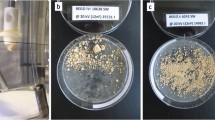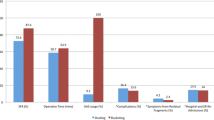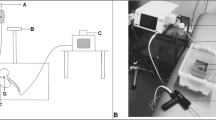Abstract
Objective
The aim of our study was to perform comparative investigation of the tissue safety of three different endoscopic lithotripter devices including a new single-probe/dual-energy lithotripter in an in vivo animal model. The Swiss LithoClast Trilogy was compared to the Storz Calcuson and the Swiss LithoClast Vario. The safety test simulated the accidental direct contact between lithotripter probes and the urothelium, which can occur when sliding off a stone or drilling through a calculus during lithotripsy. The safety test included a smallest (1.5 mm) and largest (3.3/3.4 mm) probe diameter per device.
Methods
Testing was performed in nine pigs (three animals per device). The bladder tissue was exposed to direct lithotripter probe contact at maximum power for 10 s to produce visible tissue lesions. Acute tissue trauma was evaluated using a simplified scoring model describing the expected bladder wall injuries for histological examination. After 7 days, all animals were killed, necropsied and examined post mortem. For between-group comparisons regarding microscopic histopathologic features, a Chi-square test was used. A p value < 0.05 was considered to be statistically significant.
Results
Irrespective of the lithotripter used, no systemic signs of toxicity were observed. Histologically, signs of normal ongoing healing were observed on the bladder mucosa. There were no significant differences in histological findings taking changes of the epithelium (p = 0.360), the leucocyte infiltration (p = 0.123), the vascular congestion (p = 0.929) and the edema (p = 1.0) between the groups into account.
Conclusions
The results of this study demonstrated a comparable safety between all lithotripsy devices.






Similar content being viewed by others
References
York NE et al (2017) Randomized controlled trial comparing three different modalities of lithotrites for intracorporeal lithotripsy in percutaneous nephrolithotomy. J Endourol 31(11):1145–1151
Khemees TA et al (2013) Histologic impact of dual-modality intracorporeal lithotripters to the renal pelvis. Urology 82(1):27–32
Lowe G, Knudsen BE (2009) Ultrasonic, pneumatic and combination intracorporeal lithotripsy for percutaneous nephrolithotomy. J Endourol 23(10):1663–1668
VonDerHaar JN et al (2010) In vitro evaluation of the Lithoclast Ultra Vario combination lithotrite. Urol Res 38(6):485–489
Kim SC et al (2007) In vitro assessment of a novel dual probe ultrasonic intracorporeal lithotriptor. J Urol 177(4):1363–1365
Sarkissian C et al (2015) Tissue damage from ultrasonic, pneumatic, and combination lithotripsy. J Endourol 29(2):162–170
Marberger M et al (1985) Late sequelae of ultrasonic lithotripsy of renal calculi. J Urol 133(2):170–173
Alken P (2018) Intracorporeal lithotripsy. Urolithiasis 46(1):19–29
Krambeck AE et al (2011) Randomized controlled, multicentre clinical trial comparing a dual-probe ultrasonic lithotrite with a single-probe lithotrite for percutaneous nephrolithotomy. BJU Int 107(5):824–828
Chew BH et al (2011) The Canadian StoneBreaker trial: a randomized, multicenter trial comparing the LMA StoneBreaker and the Swiss LithoClast(R) during percutaneous nephrolithotripsy. J Endourol 25(9):1415–1419
Pietrow PK et al (2003) Clinical efficacy of a combination pneumatic and ultrasonic lithotrite. J Urol 169(4):1247–1249
Scotland KB et al (2017) Stone technology: intracorporeal lithotripters. World J Urol 35(9):1347–1351
Denstedt JD, Eberwein PM, Singh RR (1992) The Swiss Lithoclast: a new device for intracorporeal lithotripsy. J Urol 148(3 Pt 2):1088–1090
Schulze H et al (1993) The Swiss Lithoclast: a new device for endoscopic stone disintegration. J Urol 149(1):15–18
Auge BK et al (2002) In vitro comparison of standard ultrasound and pneumatic lithotrites with a new combination intracorporeal lithotripsy device. Urology 60(1):28–32
Karakan T et al (2013) Comparison of ultrasonic and pneumatic intracorporeal lithotripsy techniques during percutaneous nephrolithotomy. Sci World J 2013:604361
Zengin K et al (2014) Comparison of pneumatic, ultrasonic and combination lithotripters in percutaneous nephrolithotripsy. Int Braz J Urol 40(5):650–655
Mugiya S et al (2004) Endoscopic features of impacted ureteral stones. J Urol 171(1):89–91
Yamaguchi K et al (1999) Characterization of ureteral lesions associated with impacted stones. Int J Urol 6(6):281–285
Gecit I et al (2014) Tissue damage in kidney, adrenal glands and diaphragm following extracorporeal shock wave lithotripsy. Toxicol Ind Health 30(9):845–850
Santa-Cruz RW, Leveillee RJ, Krongrad A (1998) Ex vivo comparison of four lithotripters commonly used in the ureter: what does it take to perforate? J Endourol 12(5):417–422
Piergiovanni M et al (1994) Ureteral and bladder lesions after ballistic, ultrasonic, electrohydraulic, or laser lithotripsy. J Endourol 8(4):293–299
Denstedt JD et al (1995) Investigation of the tissue effects of a new device for intracorporeal lithotripsy—the Swiss Lithoclast. J Urol 153(2):535–537
Funding
EMS Switzerland supplied the lithotripsy test equipment as well as all needed endoscopic facilities to study site. The company provided funding to acquire the test animals including animal housing during the study duration and the clinical research organization (CRO) to prepare the GLP compliant study protocol, study outcome analysis and study report including tissue histology.
Author information
Authors and Affiliations
Contributions
WK: project development, data collection, data analysis, manuscript writing/editing. FS: project development, data collection, data analysis, manuscript writing/editing. AA: data analysis, manuscript editing. MS: manuscript editing. CS: manuscript. MJB: project development, data collection, data analysis, manuscript writing/editing.
Corresponding author
Ethics declarations
Conflict of interest
All authors disclose any commercial association that might pose a conflict in connection with current submitted article.
Research involving animals
The study was approved and consented by the local ethic committee (Study no.: 126604B).
Additional information
Publisher's Note
Springer Nature remains neutral with regard to jurisdictional claims in published maps and institutional affiliations.
Rights and permissions
About this article
Cite this article
Khoder, W., Strittmatter, F., Alghamdi, A. et al. Comparative evaluation of tissue damage induced by ultrasound and impact dual-mode endoscopic lithotripsy versus conventional single-mode ultrasound lithotripsy. World J Urol 38, 1051–1058 (2020). https://doi.org/10.1007/s00345-019-02747-1
Received:
Accepted:
Published:
Issue Date:
DOI: https://doi.org/10.1007/s00345-019-02747-1




